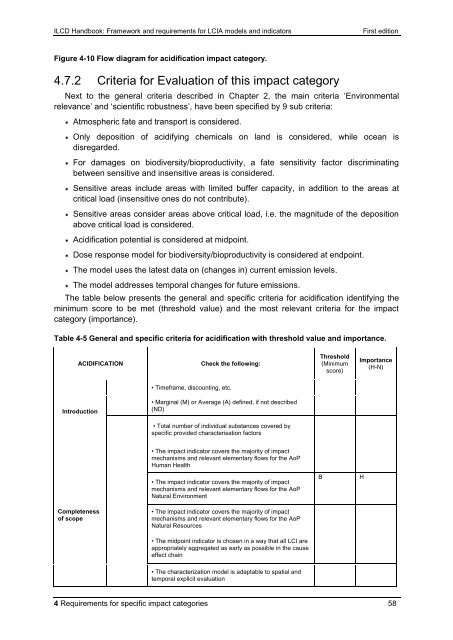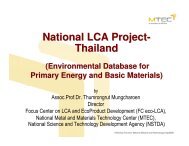ILCD Handbook: Framework and requirements for LCIA models and ...
ILCD Handbook: Framework and requirements for LCIA models and ...
ILCD Handbook: Framework and requirements for LCIA models and ...
You also want an ePaper? Increase the reach of your titles
YUMPU automatically turns print PDFs into web optimized ePapers that Google loves.
<strong>ILCD</strong> <strong>H<strong>and</strong>book</strong>: <strong>Framework</strong> <strong>and</strong> <strong>requirements</strong> <strong>for</strong> <strong>LCIA</strong> <strong>models</strong> <strong>and</strong> indicators First edition<br />
Figure 4-10 Flow diagram <strong>for</strong> acidification impact category.<br />
4.7.2 Criteria <strong>for</strong> Evaluation of this impact category<br />
Next to the general criteria described in Chapter 2, the main criteria ‗Environmental<br />
relevance‘ <strong>and</strong> ‗scientific robustness‘, have been specified by 9 sub criteria:<br />
Atmospheric fate <strong>and</strong> transport is considered.<br />
Only deposition of acidifying chemicals on l<strong>and</strong> is considered, while ocean is<br />
disregarded.<br />
For damages on biodiversity/bioproductivity, a fate sensitivity factor discriminating<br />
between sensitive <strong>and</strong> insensitive areas is considered.<br />
Sensitive areas include areas with limited buffer capacity, in addition to the areas at<br />
critical load (insensitive ones do not contribute).<br />
Sensitive areas consider areas above critical load, i.e. the magnitude of the deposition<br />
above critical load is considered.<br />
Acidification potential is considered at midpoint.<br />
Dose response model <strong>for</strong> biodiversity/bioproductivity is considered at endpoint.<br />
The model uses the latest data on (changes in) current emission levels.<br />
The model addresses temporal changes <strong>for</strong> future emissions.<br />
The table below presents the general <strong>and</strong> specific criteria <strong>for</strong> acidification identifying the<br />
minimum score to be met (threshold value) <strong>and</strong> the most relevant criteria <strong>for</strong> the impact<br />
category (importance).<br />
Table 4-5 General <strong>and</strong> specific criteria <strong>for</strong> acidification with threshold value <strong>and</strong> importance.<br />
ACIDIFICATION Check the following:<br />
Introduction<br />
Completeness<br />
of scope<br />
• Timeframe, discounting, etc.<br />
• Marginal (M) or Average (A) defined, if not described<br />
(ND)<br />
• Total number of individual substances covered by<br />
specific provided characterisation factors<br />
• The impact indicator covers the majority of impact<br />
mechanisms <strong>and</strong> relevant elementary flows <strong>for</strong> the AoP<br />
Human Health<br />
• The impact indicator covers the majority of impact<br />
mechanisms <strong>and</strong> relevant elementary flows <strong>for</strong> the AoP<br />
Natural Environment<br />
• The impact indicator covers the majority of impact<br />
mechanisms <strong>and</strong> relevant elementary flows <strong>for</strong> the AoP<br />
Natural Resources<br />
• The midpoint indicator is chosen in a way that all LCI are<br />
appropriately aggregated as early as possible in the cause<br />
effect chain<br />
• The characterization model is adaptable to spatial <strong>and</strong><br />
temporal explicit evaluation<br />
Threshold<br />
(Minimum<br />
score)<br />
B H<br />
Importance<br />
(H-N)<br />
4 Requirements <strong>for</strong> specific impact categories 58



